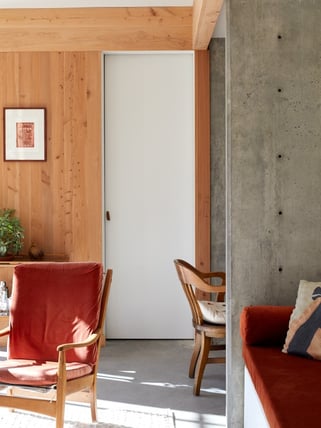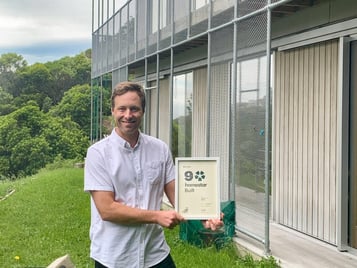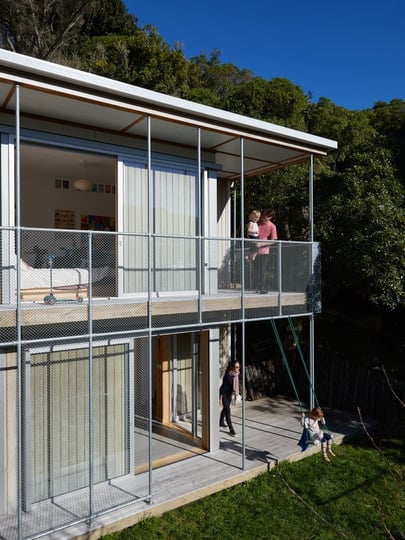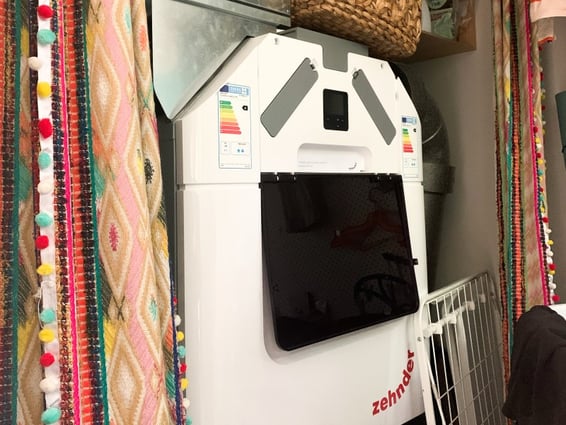Watch Karl Wakelin and Amélie Goldberg's home feature this week on Grand Designs, Thursday 7.30pm on TV3
Project Summary
Rating: 9 Homestar built rating
Location: Barnard St, Wellington
Owners: Karl Wakelin and Amélie Goldberg
Completion: Moved in July 2018
Size: 140sq/m

A draughty old villa will set you back more than a million dollars in Wellington. The thought of forking out that amount of money only to have to then spend years fixing it up didn’t appeal to Karl Wakelin and his wife Amélie Goldberg.
“I saw coming back from the States that we just weren’t doing much. The quality of our housing stock is so low, I saw an opportunity to do it and say well this is what can be done," Karl said.
As a sustainable design expert at Stephenson & Turner, Karl wanted to build a comfortable home that also provided a case study for what he preaches at work every day.
“I can tell clients now, the airtightness layer for example is not hard, it’s easy, it’s not rocket science it’s just something that’s got to be thought about.”
They found an affordable, yet steep, site in Wadestown. Armed with a design by architect friend Ben Mitchell-Anyon, the couple picked up their tools alongside Karl's builder dad Max in early 2017.
“If we’d paid someone to do it we would have had to spend easily a million bucks. Instead, we’ve spent about 500k and we’ve built it all ourselves”.
Project TeamArchitect: Ben Mitchell-Anyon, Patchwork Architecture Builder: Max Wakelin, Karl Wakelin, Tim Silvester, Amélie Goldberg Airtightness: Richard Eden, Pro clima Thermal Modelling: Stephenson & Turner |
 |

The impressive 19-month project was documented by TV3’s Grand Designs, with the final three-bedroom home Wellington’s first to receive a 9 Homestar rating.
“I wanted something that was damn efficient with low energy bills and that’s what we’ve got. And we’ve got a house which is very liveable.”
Key to the home’s success and comfort is the focus on its thermal envelope. While the project did not target Passive
House in addition to Homestar, Karl says fundamental passive elements like high levels of insulation, airtightness, and heat recovery ventilation were instrumental in creating a space that stays warm in winter and cool in summer.
“There are two layers of insulation so thermal bridging is minimised hugely. We have a second layer of 45mm insulation on the inside of the ceilings and all the walls. The concrete slab is a floating floor that is fully insulated as well.”
The design maximises the concrete as a heat source, with windows helping it capture the warmth from the sun during winter but stay shaded during the summer.
"We don’t overheat, we don’t have much west or east facing glass which on days like this you can understand why. We would be cooking – when the sun’s low in the sky and it comes in we’d be too hot because the energy’s got nowhere to go."
A sole 2kW electric panel heater is the only thing needed to top things up on very cold days.
An airtightness and vapor control layer helped ensure an impressive result when the folks at Pro Clima came to do their blower door test.
“We got an air tightness test and we hit 0.8 air changes per hour (ach). To get full points in Homestar you need to get below 1ach and as an indicator – for Passive House you need to be at 0.6ach so we were right between the two. To be honest anything below 1ach is really impressive.”
The average for new build stand-alone homes in New Zealand is estimated to be around 5ach.
“Air tightness and ventilation – two things our building code is pretty hopeless at really. Build tight, ventilate right, that’s the saying.”
Another key piece of the puzzle, and something Karl now raves about, is the inclusion of a 93% efficient heat recovery ventilation system.
“Honestly, I’d suggest any house anywhere in the world should have them.”
“They’re amazing. Especially in Wellington. When it’s super windy and you don’t really want to open the windows, we can keep them closed and we’re still getting fresh air. I know my girls are getting fresh air all night when they’re sleeping and their rooms aren’t filling up with CO2 if the windows are closed. But it also means you can open the house up when you want to too. So on a sunny day like today our house is open.”

By doing it himself he was able to carefully manage construction waste, diverting at least 80% from landfill.
“The nature of the site meant that we didn’t want to carry anything down that hill that we had to take back out again. Everything is quite modular so we didn’t have many offcuts of plywood or anything like that. We just did a conscientious job of tracking everything. We reused any concrete or rocks, anything heavy – we used that in drainage.”
All up, Karl Wakelin's home was able to tick many boxes, from super-efficient design, appliances and use of space, to sustainably sourced local timber, high insulation levels and low E, argon gas filled glass.
"To get 9 Homestar without renewable energy, really you need to get points everywhere. The only places we didn’t really get points were the ones I couldn’t change. Our site we weren’t close to four amenities, we couldn’t get universal design credits for our house because we’re down 100 stairs so it just wasn’t possible."
"Do the basics of the envelope right and you’ll be a long way there when it comes to getting a home that’s comfortable and efficient."
Sustainable features include:
- Rooftop rainwater harvesting
- 93% efficient Heat recovery ventilation
- Fully insulated floating concrete slab
- Insulation double code requirements
- Airtightness and vapour control layer
- Blower door test results of 0.8 air changes per hour.
- All glass is low E, low E Max, and argon gas filled
- Thermally broken frames
- Sustainable materials including locally sourced, FSC certified timber for decking and cladding.
- Bike parking
- Energy and water efficient appliances and fixtures
- Eco approved sealants and paints
- 80% of construction waste diverted from landfill
